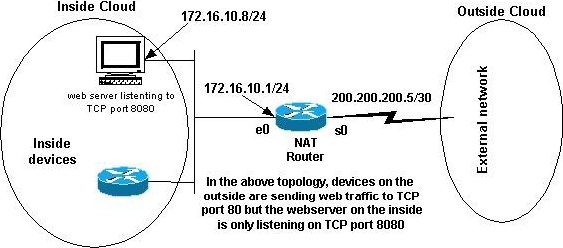Refer to the following configuration command.
router(config)# ip nat inside source static tcp 172.16.10.8 8080 172.16.10.8 80
Which statement about the command is true?
A . Any packet that is received in the inside interface with a source IP port address of 172.16.10.8:80 is translated to 172.16.10.8:8080.
B . Any packet that is received in the inside interface with a source IP port address of 172.16.10.8:8080 is translated to 172.16.10.8:80.
C . The router accepts only a TCP connection from port 8080 and port 80 on IP address 172.16.10.8
D . Any packet that is received in the inside interface with a source IP address of 172.16.10.8 is redirected to port 8080 or port 80.
Answer: B
Explanation:
Having a web server on the internal network is another example of when it may be necessary for devices on the internet to initiate communication with internal devices. In some cases the internal web server may be configured to listen for web traffic on a TCP port other than port 80. For example, the internal web server may be configured to listen to TCP port 8080. In this case, you can use NAT to redirect traffic destined to TCP port 80 to TCP port 8080.

After you define the interfaces as shown in the previous network diagram, you may decide that you want NAT to redirect packets from the outside destined for 172.16.10.8:80 to 172.16.10.8:8080. You can use a static nat command in order to translate the TCP port number to achieve this. http://www.cisco.com/c/en/us/support/docs/ip/network-address-translation-nat/13772-12.ht
